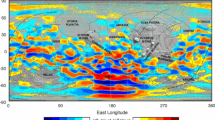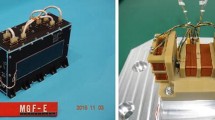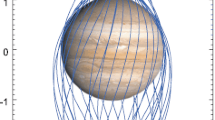Abstract
The magnetometer on the POLAR Spacecraft is a high precision instrument designed to measure the magnetic fields at both high and low altitudes in the polar magnetosphere in 3 ranges of 700, 5700, and 47000 nT. This instrument will be used to investigate the behavior of fieldaligned current systems and the role they play in the acceleration of particles, and it will be used to study the dynamic fields in the polar cusp, magnetosphere, and magnetosheath. It will measure the coupling between the shocked magnetosheath plasma and the near polar cusp magnetosphere where much of the solar wind magnetosphere coupling is thought to take place. Moreover, it will provide measurements critical to the interpretation of data from other instruments. The instrument design has been influenced by the needs of the other investigations for immediately useable magnetic field data and high rate (100+vectors s−1) data distributed on the spacecraft. Data to the ground includes measurements at 10 vectors per second over the entire orbit plus snapshots of 100 vectors per second data. The design provides a fully redundant instrument with enhanced measurement capabilities that can be used when available spacecraft power permits.
Similar content being viewed by others
References
Aubry, M. P., Kivelson M. G., and Russell, C. T.: 1971, ‘Motion and Structure of the Magnetopause’,J. Geophys. Res. 76(7), 1673.
Birkeland, K.: 1908,The Norwegian Aurora Polaris Expedition 1902–1903, H. Aschehoug and Co., Christiania.
Cummings, W. D. and Dessler, A. J.: 1967, ‘Field-aligned Currents in the Magnetosphere’,J. Geophys. Res. 72, 604.
Dungey, J. W.: 1961, ‘Interplanetary Magnetic Field and Auroral Zones’,Phys. Rev. Letters 6, 47.
Gordon, D. I. and Brown, R. E.: 1972, ‘Recent Advances in Fluxgate Magnetometry’,IEEE Transactions on Magnetics MAG-8, 76.
Hedgecock, P. C.: 1975, ‘Magnetometer Experiments in the ESRO HEOS Spacecraft’,Space Sci. Inst. I 61, 1975.
Iijima, T. and Potemra, T. A.: 1976, ‘The Amplitude Distribution of Field Aligned Currents at Northern High Latitudes Observed by TRIAD’,J. Geophys. Res. 81, 2165.
Kivelson, M. G., Khurana, K. K., Means, J. D., Russell, C. T., and Snare, R. C.: 1992, ‘The Galileo Magnetic Field Investigation’,Space Sci Rev. 60, 357.
Paschmann, G., Sonnerup, B. U. O., Papamastorakis, I., Sckopke, N., Haerendel, G., Bame, S. J., Asbridge, J. R., Gosling, J. T., Russell, C. T., and Elphic, R. C.: 1979, ‘Plasma Acceleration at the Earth's Magnetopause: Evidence for Reconnection’,Nature 282, 243.
Peredo, M., Stern, D. P., and Tsyganenko, N. A.: 1993, ‘Are Existing Magnetospheric Models Excessively Stretched?’,J. Geophys. Res. 98, 15343.
Podgorny, I. M., Dubinin, E. M., and Potanin, Yu. N.: 1980, ‘On Magnetic Curl in Front of the Magnetopause Boundary’,Geophys. Res. Letters 7, 247.
Russell, C. T.: 1978, ‘The ISEE 1 and 2 Fluxgate Magnetometers’,IEEE Trans. Geoscience Electronics GE-16, 239.
Russell, C. T. and McPherron, R. L.: 1973, ‘The Magnetotail and Substorms’,Space Sci. Rev. 15, 205.
Snare, R. C. and Means J. D.: 1977, ‘A Magnetometer for Pioneer Venus Orbiter’,IEEE Transactions on Magnetics MAG-13(5).
Sonnerup B. U. O., Paschmann, G., Papamastorakis, I., Sckopke, N., Haerendel, G., Bame, S. J., Asbridge, J. R., Gosling J. T., and Russell, C. T.: 1981, ‘Evidence for Magnetic Field Reconnection at the Earth's Magnetopause’,J. Geophys. Res. 86, 10049.
Stewart, B.: 1882,Terrestrial Magnetism, Encyclopedia Britannica, A. C. Black Edinburgh.
Tsyganenko, N. A.: 1989a, ‘A Magnetospheric Magnetic Field Model with a Warped Tail Current Sheet’,Planetary Space Sci. 37, 5.
Van Allen, J. A.: 1992, ‘Observed Currents on the Earth's High-Latitude Magnetosphere’,J. Geophys Res. 97, 6381.
Zanetti, L. J., Baumjohann, W., and Potemra, T. A.: 1983, ‘Ionospheric and Birkeland Currents Distributions Inferred from the MAGSAT Magnetometer Data’,J. Geophys. Res. 88, 4875.
Zmuda A. J., Martin, J. H., and Heuring, F. T.: 1966, ‘Transverse Magnetic Disturbances at 110 km in the Auroral Region’,J. Geophys. Res. 71, 5033.
Author information
Authors and Affiliations
Rights and permissions
About this article
Cite this article
Russell, C.T., Snare, R.C., Means, J.D. et al. The GGS/POLAR magnetic fields investigation. Space Sci Rev 71, 563–582 (1995). https://doi.org/10.1007/BF00751341
Received:
Issue Date:
DOI: https://doi.org/10.1007/BF00751341




